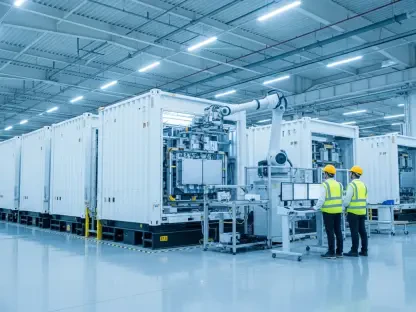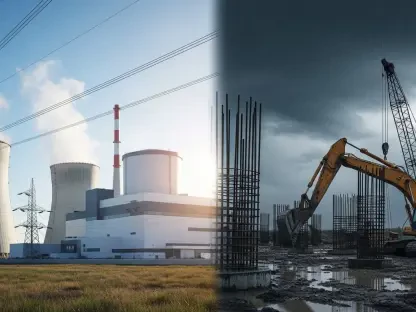Embarking on a mission to reduce energy costs in laundry facilities begins with a thorough understanding of where and how savings can be achieved. With energy prices steadily on the rise, these audits have become invaluable tools for operators aiming to streamline their operations and enhance profitability. Strategic system audits provide clear, actionable insights that can lead to significant cost reductions, ensuring that businesses remain competitive and sustainable in an increasingly costly energy market.
Understanding the Importance of Energy Audits
Energy audits are systematic evaluations of a facility’s energy consumption and use patterns, offering a comprehensive view of where improvements can be made. These audits play a pivotal role in identifying inefficiencies within the system and providing actionable insights for enhancement. By meticulously examining utility bills, equipment performance, and maintenance practices, energy audits pave the way for effective steps to reduce energy waste and lower operational costs, which is crucial for maintaining a competitive edge in the laundry industry.
The meticulous nature of energy audits entails a detailed analysis of all energy-consuming aspects of the facility. Auditors typically start by reviewing utility bills to establish baseline energy usage and identify unusual consumption patterns. This initial overview helps in pinpointing areas where energy is potentially wasted. Following this, a thorough inspection of the facility is conducted, focusing on all major systems and equipment. The aim is to uncover areas of inefficiency, such as outdated machinery or poor maintenance practices, which can inflate energy costs unnecessarily. By identifying these problem areas, operators can take targeted actions to optimize energy use and achieve significant cost savings.
Increasing Energy Costs
In recent years, energy costs have seen a substantial increase, comprising a notable portion of operational expenses for businesses, including laundry services. Prices for electricity, natural gas, and fuel oil have consistently trended upwards, creating a financial pinch for operators. This upward trend underscores the importance of conducting regular energy audits to manage and mitigate these rising expenses effectively. Notably, without a strategic approach to energy management, businesses risk significant financial strain due to escalating energy bills.
The impact of rising energy costs extends beyond mere financial concerns; it also affects the overall sustainability of operations. As energy prices increase, the cost-benefit balance of maintaining older, less efficient equipment diminishes. This makes it increasingly critical for laundry service operators to seek out energy-saving opportunities through regular audits. Identifying inefficient practices or outdated technologies early on allows for more informed decisions about upgrades and optimizations. This proactive approach not only addresses immediate cost concerns but also sets the stage for long-term, sustainable efficiency in operations.
The Energy Audit Process
Conducting an energy audit involves a series of well-defined steps aimed at uncovering inefficiencies and identifying areas for improvement. The process begins with a detailed analysis of the facility’s utility bills, which allows auditors to discern patterns in energy consumption and pinpoint potential issues. This step helps establish a comprehensive understanding of the facility’s energy use, serving as a critical foundation for the subsequent parts of the audit. Following this initial assessment, auditors conduct a comprehensive inspection of all major systems and equipment within the facility to identify inefficiencies and potential areas for energy savings.
During the inspection phase, auditors pay close attention to key aspects such as heating, ventilation, air conditioning systems, lighting, and process equipment. Any signs of malfunction, wear and tear, or inefficiency are meticulously documented. Additionally, the audit process evaluates the effectiveness of current maintenance practices. Regular preventive maintenance is a focal point, as it plays a significant role in ensuring optimal equipment performance and preventing unnecessary energy waste. By thoroughly examining these elements, auditors can provide actionable recommendations that lead to significant improvements in energy efficiency and cost savings.
Equipment Performance and Maintenance
One of the crucial elements examined during an energy audit is the performance and maintenance of the facility’s equipment. Equipment inefficiencies can dramatically inflate energy usage and, consequently, operational costs. Auditors frequently uncover that inadequate or irregular maintenance practices contribute significantly to energy wastage. Regular preventive maintenance, therefore, is emphasized as a key strategy for reducing energy consumption and enhancing overall efficiency. By ensuring that equipment operates at optimal levels, facilities can avoid unnecessary energy expenses and improve their cost-effectiveness.
Common maintenance-related issues identified during audits include wear and tear of components, improper calibration, and inadequate lubrication. These seemingly minor issues can cumulatively lead to substantial energy losses if left unaddressed. Auditors often recommend the implementation of systematic maintenance schedules and the use of monitoring tools to track equipment performance in real time. This proactive approach helps identify potential issues before they escalate into major problems, thus preventing costly downtime and energy waste. By prioritizing regular and thorough maintenance, laundry facilities can ensure sustained energy efficiency and operational reliability.
Identifying Common Issues
Energy audits often reveal recurring issues within laundry facilities that, if left unaddressed, can result in substantial energy losses. Among the most common problems identified are steam leaks, air leaks, and water waste. Steam leaks, for instance, can waste significant amounts of energy, as steam is a major contributor to the overall energy use in laundry operations. Similarly, air leaks in compressed air systems can lead to substantial electricity wastage, given that compressors are energy-intensive devices. Addressing these leaks promptly can result in considerable energy savings and improved efficiency.
Water waste is another frequent issue, often stemming from inefficient washing processes or improperly maintained equipment. Clogged washer drains, for example, can lead to excessive water usage and higher energy costs as more energy is required to heat and circulate unnecessary water. By pinpointing such inefficiencies through energy audits, operators can implement targeted measures to mitigate these problems. Solutions may include installing water recycling systems, improving drainage maintenance, and optimizing washing cycles. Addressing these common issues not only enhances energy efficiency but also contributes to more sustainable and cost-effective operations.
Advanced Strategies for Efficiency
Implementing advanced strategies is essential to address the inefficiencies identified during energy audits and achieve significant energy savings. One such strategy is heat reclamation, which involves capturing and reusing waste heat from processes such as wastewater, boiler exhausts, and dryer exhausts. This reclaimed heat can then be used to preheat incoming water or air, reducing the need for additional energy input. Water reuse and recycling systems can also generate substantial savings by minimizing the volume of fresh water needed for operations. These systems can reclaim water from various stages of the washing process and reuse it, thereby reducing both water and energy consumption.
Another effective strategy is the installation of variable frequency drives (VFDs) on motors and pumps. VFDs adjust the speed of electric motors to match the required load, optimizing energy use and reducing unnecessary consumption. Additionally, upgrading to LED lighting can significantly decrease energy costs, as LEDs use less power and have a longer lifespan compared to traditional lighting options. These advanced measures not only address the immediate inefficiencies highlighted in energy audits but also pave the way for long-term energy and cost savings. By adopting such strategies, laundry facilities can enhance their operational efficiency and sustainability.
The Role of Technological Upgrades
Upgrading to more efficient technologies plays a substantial role in reducing energy consumption and optimizing operational performance. Energy audits often highlight the need to modernize outdated equipment, which can be a significant source of energy inefficiency. Investing in new technologies and systems can lead to remarkable long-term savings. For instance, the adoption of high-efficiency boilers, advanced HVAC systems, and energy-efficient dryers can drastically cut energy usage. Additionally, smart automation systems that monitor and control energy use in real time can further enhance efficiency by ensuring that equipment operates only when necessary.
Technological upgrades also extend to integrating renewable energy sources, such as solar panels or geothermal systems, into the energy grid of the facility. These renewable sources can offset a portion of energy needs, reducing reliance on conventional, and often more expensive, energy sources. By implementing these upgrades, laundry facilities can benefit from lower energy costs, reduced environmental impact, and increased operational reliability. Embracing technological advancements not only aligns with energy audit recommendations but also positions businesses to thrive in an energy-conscious market.
Optimized Workflows and Scheduling
Optimizing workflows and scheduling based on findings from energy audits can lead to significant improvements in energy management. Adjustments to operational schedules, such as aligning laundry processes with periods of lower energy demand and cost, can effectively reduce overall expenses. For example, running high-energy-consuming equipment during off-peak hours when electricity rates are lower can result in substantial cost savings. Additionally, optimizing the order and timing of different laundry processes can enhance efficiency by reducing idle time and ensuring that equipment operates at peak performance levels.
Furthermore, improving process workflows to minimize bottlenecks and streamline operations can reduce energy consumption. For instance, coordinating washing, drying, and finishing processes to minimize downtime between stages can enhance overall efficiency. Implementing real-time monitoring and control systems can also help operators make informed decisions about energy use, allowing for timely adjustments to maintain optimal performance. By leveraging the insights provided by energy audits to refine workflows and scheduling, laundry facilities can achieve significant energy and cost savings while maintaining high levels of productivity and service quality.
Ensuring Long-Term Savings
To kickstart a mission to slash energy costs in laundry facilities, it’s crucial to have a solid grasp of where and how you can save. With energy prices constantly climbing, these audits are now indispensable for operators determined to streamline operations and boost profitability. By conducting strategic system audits, businesses can gain clear, actionable insights that lead to substantial cost reductions. This not only helps in cutting expenses but also ensures that companies stay competitive and maintain sustainability in an ever more expensive energy market. Through a meticulous examination of energy usage, operators can uncover areas where efficiency can be improved. This could involve upgrading equipment to more energy-efficient models, optimizing operational schedules, or implementing energy-saving technologies. Additionally, training staff on energy conservation techniques can contribute significantly to reducing consumption. In essence, thorough energy audits equip laundry facilities with the knowledge and tools necessary to make informed decisions that result in lower energy costs, thereby supporting long-term operational success and environmental responsibility.









